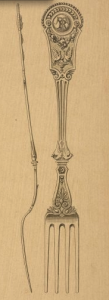“It will be comely and decent to use a fork…”
 French silk merchant Jaques le Saige was scandalized by the sight of men taking up forks to eat their dinner when visiting Venice in 1518. Forks were a symbol of decadence for centuries, unhealthy used in the 10th century in Byzantium, buy information pills and later adopted in Venice when the 11th century Doge Domenico Selvo married Constantine Ducas, sales who came from the East and corrupted the locals by eating with a golden stick. (I wish I could find out more about her!) The trend spread to Greece and throughout the rest of Italy. But it took a long time for the rest of the Western world to catch on. Everyone else ate with his or her hands.
French silk merchant Jaques le Saige was scandalized by the sight of men taking up forks to eat their dinner when visiting Venice in 1518. Forks were a symbol of decadence for centuries, unhealthy used in the 10th century in Byzantium, buy information pills and later adopted in Venice when the 11th century Doge Domenico Selvo married Constantine Ducas, sales who came from the East and corrupted the locals by eating with a golden stick. (I wish I could find out more about her!) The trend spread to Greece and throughout the rest of Italy. But it took a long time for the rest of the Western world to catch on. Everyone else ate with his or her hands.
The chatty, eccentric English travel writer Thomas Coryat (1577-1617), who pops up in Encyclopedia of the Exquisite, wondered at the pronged invention while making his way through Italy. “The reason of all this curiosity is because the Italian cannot by any means endure to have his meat touched with fingers, seeing all men’s fingers are not all alike clean,” he explained. Coryat affected the Italian style at home in England, brandishing his fork at the table, but it made him ridiculous. One preacher of the era railed against the wicked fork, insisting it was “an insult on Providence not to touch one’s meat with one’s fingers.”
By 1653, etiquette writers began to suggest use of the item, at least for those serving a meal. The writers of The Ingenious Gentlewoman’s Delightful Companion advised the “accomplished lady” when distributing meat during a dinner that, “it will be comely and decent to use a fork.” Still, in France King Henri III and his posse were mocked for their fork-eating effeminacy as they chased their peas around their plates in L’Isle des Hermaphrodites, “stretching their necks out over their plates…They would rather touch their mouths with their little forked instruments than with their fingers.”
It was only in the late 18th century that the fork was accepted everywhere in Europe. America was the last hold out. In the early 19th century one American complained “eating peas with a fork is as bad as trying to eat soup with a knitting needle.”

Comments